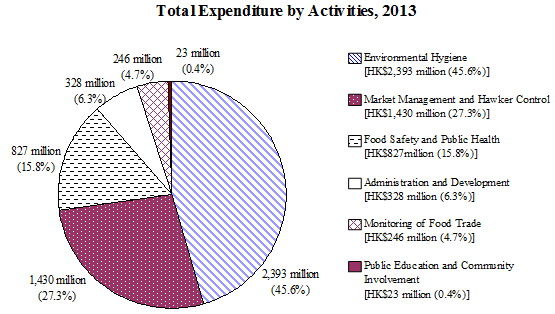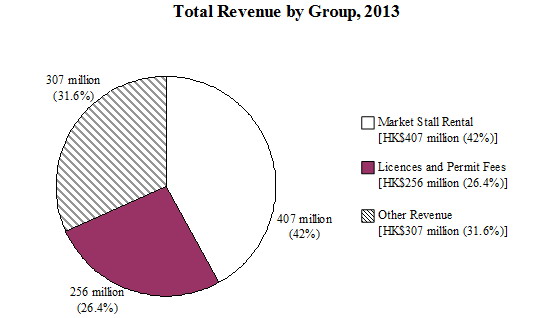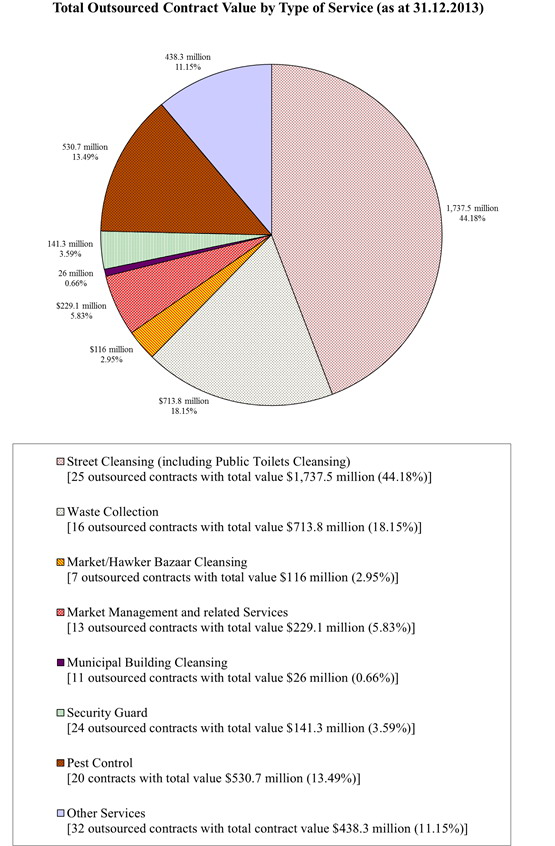The Administration and Development Branch provides various management and support services to the Department.
Grade Management
There are three major grades covering Health Inspectors, Hawker Control Officers and Foremen. Two grade managers, one for the Health Inspector grade and another for the Hawker Control Officer and Foreman grades, are responsible for staff matters involving manpower planning, career development, postings, promotion and training.
Health Inspectors are responsible for various environmental hygiene and food safety functions, such as handling of environmental nuisance cases, hygiene inspections to food establishments, licensing, prosecution, meat inspection, cleansing services, outsourcing, pest control, hawker control, management of markets, cemeteries and crematoria, food control and health education.
Hawker Control Officers are responsible for controlling on-street hawking activities, managing hawker permitted places and taking law enforcement action against illegal hawking activities. They also play an important part in prosecuting people alleged to have committed cleanliness offences, such as littering and spitting.
Foremen are mainly responsible for supervising the work of frontline staff in street cleansing, waste collection, pest control, cemeteries and crematoria and market management. They are also responsible for transport services and monitoring the performance of the Department's service contractors. Members of the grade also take legal action against cleanliness offenders.
Training
Training and development programmes are provided to enhance the overall competence and professionalism of staff, supporting departmental initiatives, bringing out their best to serve the public, heightening their awareness of occupational safety and health, and promoting a high standard of probity in the Department. Training programmes mainly take the form of vocational, management, information technologies, occupational safety and communication courses. While the majority of training programmes were held locally, staff members would also be nominated to attend overseas programmes.
During the year, the Department organised 913 classes, which were attended by 13,572 trainees, adding up to a total of 36,789 trainee-days. These included induction training programmes for a total of 423 new recruits to equip them with the necessary knowledge and skills to discharge their duties. In addition, the Department provided sponsorship to 10 staff members to pursue employment-related studies outside office hours, and 50 officers were placed in 25 training programmes outside Hong Kong, involving a total of 308 trainee-days.
Management Services
The Management Services, Survey and Statistics Section mainly provides management consultancy and statistical services to the Department. They help the management improve the delivery of public services, monitor the standard of performance and formulate policy in the provision of services and staffing. Ongoing consultancies are provided to assist the Department in the implementation of recommendations of studies and technical advice is offered to help the Department conduct statistical surveys and analyse data.
Four management studies were completed during the year. In addition, a number of statistical surveys were conducted on issues such as public knowledge, attitude and practice regarding nutrition labelling and opinion on the Department's health education publications.
Financial Management
The subsidiary legislation regarding the alignment of 93 FEHD fee items took effect in July 2013. The legislation took forward the initiative of the 2013 Policy Address to align the different levels of fees and charges for similar municipal services in urban areas and the New Territories. The legislation provided that where the fee or charge for a service or facility differed between the urban areas and the New Territories, the lower rate prevailed. The aligned fees included certain fees for hawker licences, allocation and use of hawker pitches or stalls, liquor licences, food and trade licences, cemeteries and crematoria services, slaughterhouse licences and inspection services.



All matters relating to expenditure and procurement, including payment processing, financial advice and monitoring, are handled by the Finance and Supplies Division.
In 2013, the Department spent $5,247 million, including $2,837 million on salaries and allowances and personnel related expenses, $2,356 million on departmental expenses and other charges, and $54 million on capital and non-recurrent expenditure.
By activities, the majority of the expenditure ($2,393 million) was on environmental hygiene. This was followed by $1,430 million on market management and hawker control, $827 million on food safety and public health, $328 million on administration and development, $246 million on monitoring the food trade, and $23 million on public education and community involvement.
During the year, the Department received a revenue of $970 million. Most of the revenue came from the rental of stalls in public markets managed by the Department ($407 million) and from licence and permit fees ($256 million). Other sources included revenue from cemeteries and crematoria services ($101 million), court fines and statutory penalties ($55 million), slaughterhouse and other concessions ($95 million), meat examination ($22 million) and miscellaneous services ($34 million).
Capital Works
In the Government's 2013 Capital Works Resource Allocation Exercise, the five-year allocation on capital projects for food and environmental hygiene services is estimated at $1,360 million to meet expenditure on projects of the department.
Markets
During the year, improvement works to Sham Tseng Temporary Market and Hung Shui Kiu Temporary Market were completed. The upgrading works for fire services installation at On Ching Road Flower Market were completed in late 2013. Installation of a goods lift from ground floor to Upper 1/F at Kwun Chung Market is under planning for completion in 2015.
Refuse Collection Points
As part of the continuing efforts to improve Hong Kong's living environment, the Department is replacing temporary roadside refuse collection points (RCPs) with off-street facilities in enclosed buildings equipped with modern de-odourising installations. Reprovisioning of Tsuen Wan Transport Complex RCP under the West Rail Tsuen Wan West Station Development is scheduled for completion in mid-2014. A new RCP at Site IJ4 in Kai Tak Development is under planning for completion in 2016.
Public Toilets
Under the Public Toilet Refurbishment/Improvement Programme, 12 projects were completed in 2013 and another 104 are in progress or being planned.
The phased programme to convert identified aqua privies into flushing toilets continued in 2013. Of the 145 aqua privies included in the final phase for which works commenced in February 2011, 109 were already converted into flushing toilets, 67 of which were completed in the year. For the remaining 36 aqua privies in the final phase, 16 of them are either in progress or under planning for completion by December 2014 and the other 20 have been/will be refurbished in-situ or demolished for various reasons including project/site constraints, failure to obtain local support, local request for demolition, and remote location/ low usage rate, etc.
Cemeteries and Crematoria
Reprovisioning of Wo Hop Shek Crematorium was completed in January 2013 while that of Cape Collinson Crematorium will be completed at the end of 2015. The new Garden of Remembrance at Kiu Tau Road in Wo Hop Shek, which comprised both Western and Chinese design concepts, was open to the public in 2013.
The Government is contemplating all feasible measures to increase the supply of public columbarium facilities. These include promoting district-based columbarium development scheme and providing additional niches in existing cemeteries and columbaria. Of the 24 sites in the 18 districts identified for columbarium development, the Diamond Hill Columbarium extension (offering about 1,500 niches) and the Cheung Chau Cemetery extension (offering some 1,000 niches) were completed in April 2012 and December 2013 respectively. Detailed design and site investigation works for columbarium development at the Sandy Ridge Cemetery (expected to provide 200,000 niches by batches starting in 2022) started in June 2013. The Administration will consult the relevant District Councils before the sites are confirmed for columbarium development.
Outsourcing of Services

Grand Total: 148 contracts with a total value of $3,932.7 million
By end 2013, 148 contracts valued at $3,932.7 million were in force for the provision of services by private contractors. The outsourcing policy is aimed at greater cost-effectiveness and flexibility in the delivery of services.
Examples of outsourcing services include: street cleansing, waste collection, mechanical street sweeping, mechanical gully cleansing, collection of recyclables, market management, cleansing, pest control and related services, rodent, mosquito and other pest control services, municipal services building cleansing, security guard services, animal carcass collection, cleansing and horticultural maintenance services for cemeteries and columbaria, tree risk assessment and arboricultural services, etc.
Measurable performance standards are written into contracts to ensure the quality of services provided. Labour protection and occupational safety clauses have also been included in tenders to safeguard the rights and promote the well-being of non-skilled workers. In addition to daily checking, supervisory checks are conducted to ensure compliance with contract requirements by contractors at all times.
Complaints Management
The Complaints Management Section is responsible for formulating and reviewing policies on, and procedures for, handling all types of complaints. In 2013, the Department received 202,260 cases of service request and complaint from the public.
Quality Assurance
Continuous improvement is one of the priority tasks of the Department to ensure provision of quality services to the public.
The primary objective of the Quality Assurance Section is to monitor and improve service quality. To achieve this objective, the section conducts day-to-day regulatory inspections on services provided by the Department and service contractors. Recommendations are made for improvements to services with identified inadequacies in existing operational systems, procedures and guidelines. The section also recommends good performers for Quality Assurance Awards and Certificates of Meritorious Performance to motivate outstanding and hardworking frontline staff. In addition, the section investigates staff-related cases of dereliction of duty and employment-related complaints of service contractors in an independent, objective and fair manner. The section also conducts audit inspections and employment-related inspections to check service contractors' compliance with employment-related commitments.
Public Education and Publicity
Public education plays an important role in ensuring food safety and improving environmental hygiene. To this end, the Department organises publicity and educational programmes including talks, exhibitions and outreaching programmes to enhance the general public's awareness of these issues.
The Department operates a Health Education Exhibition and Resource Centre (the Centre) inside Kowloon Park to serve the public. It arranges group visits and guided tours for schools, elderly centres, children and youth centres, organisations for the disabled and the public. Talks and outreaching activities are also conducted regularly. During the year, the Centre attracted 108,477 visitors, and organised 1,073 talks-cum-activities for kindergartens, primary schools and secondary schools, 1,004 talks for elderly centres and 291 talks for the general public. The Mobile Education Centre (a publicity vehicle) of the Centre also conducted 222 visits to schools, housing estates and public parks as part of the outreaching efforts in promoting health education. New publicity panels were set up in the Centre to enhance promotion of healthy living messages.
To meet the targeted risk communication needs on food safety, there is also a dedicated Communication Resource Unit (CRU) under the Centre for Food Safety to serve the public and the food trade. Located at the Fa Yuen Street Municipal Services Building, the CRU maintains a rich collection of food safety related promotion resource materials, ranging from Five Keys to Food Safety, the Hazard Analysis and Critical Control Point (HACCP) system, risk perception, to other food safety initiatives and new regulations. It has designated exhibition areas and information corners equipped with audio-visual facilities. The CRU also entertains requests for organised visits and food safety talks, and provides loan service of resource materials, exhibition boards and audio-visual resources for schools, community centres and other interested public. Apart from supporting initiatives and events on food safety risk communication, the CRU conducts regular education programmes throughout the year. In 2013, the CRU conducted 319 seminars, workshops and various types of publicity activities including roving exhibitions on food safety for the public and selected target groups, including food handlers, school children, the elderly and ethnic minorities.
During the year, the Department continued its publicity on disseminating environmental hygiene messages through Television and Radio Announcements in the Public Interest, banners, posters, pamphlets and leaflets. Anti-rodent and anti-mosquito campaigns were organised to solicit public support and participation in pest control. Support was also given to cleansing campaign/work by non-government organisations.





